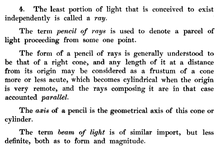Pencil (optics)


In optics, a pencil or pencil of rays is a geometric construct used to describe a beam or portion of a beam of electromagnetic radiation or charged particles, typically in the form of a narrow beam (conical or cylindrical).
Antennas which strongly bundle in azimuth and elevation are often described as "pencil-beam" antennas. For example, a phased array antenna can send out a beam that is extremely thin. Such antennas are used for tracking radar, and the process is known as beamforming.
In optics, the focusing action of a lens is often described in terms of pencils of rays. In addition to conical and cylindrical pencils, optics deals with astigmatic pencils as well.[1]
In electron optics, scanning electron microscopes use narrow pencil beams to achieve a deep depth of field.[2]
Ionizing radiation used in radiation therapy, whether photons or charged particles, such as proton therapy and electron therapy machines, is sometimes delivered through the use of pencil beam scanning.[3]
In backscatter X-ray imaging a pencil beam of x-ray radiation is used to scan over an object to create an intensity image of the Compton-scattered radiation.
History
[edit]

A 1675 work describes a pencil as "a double cone of rays, joined together at the base."[4] In his 1829 A System of Optics, Henry Coddington defines a pencil as being "a parcel of light proceeding from some one point", whose form is "generally understood to be that of a right cone" and which "becomes cylindrical when the origin is very remote".[5]
See also
[edit]- Collimated beam
- Pencil (mathematics), a family of geometric objects having a common property such as passage through a given point.
- Fan beam
- Pencil beam scanning (Medical physics)
- Microwave transmission
References
[edit]- ^ Edward L. Nichols & William S. Franklin (1903). The Elements of Physics: A College Text-book. Macmillan Co. p. 77.
- ^ Nick Johnson (19 May 1983). "The art of seeing the very small". New Scientist. 98 (1358): 472.
- ^ Faiz M. Khan (2009). The Physics of Radiation Therapy (4th ed.). Lippincott Williams & Wilkins. pp. 521–522. ISBN 978-0-7817-8856-4.
- ^ Bailey, Nathan (1675). "An Universal Etymological English Dictionary". Retrieved 24 November 2022.
- ^ Coddington, Henry (1829). A System of Optics: A treatise on the reflexion and refraction of light. -pt.2 A treatise on the eye and on optical instruments. J. Smith. Retrieved 24 November 2022.
Text is available under the CC BY-SA 4.0 license; additional terms may apply.
Images, videos and audio are available under their respective licenses.
